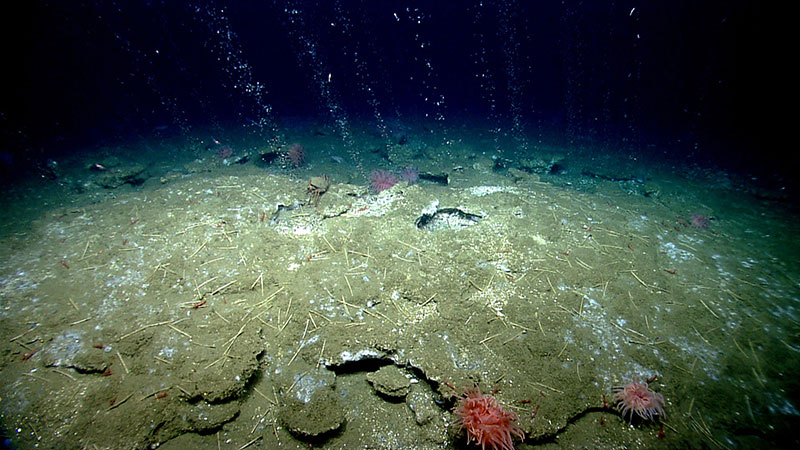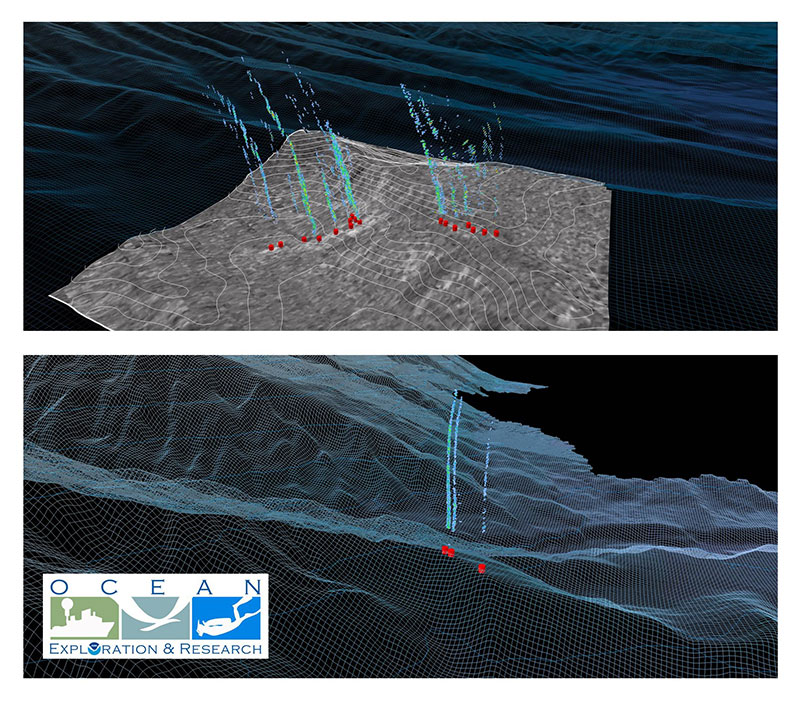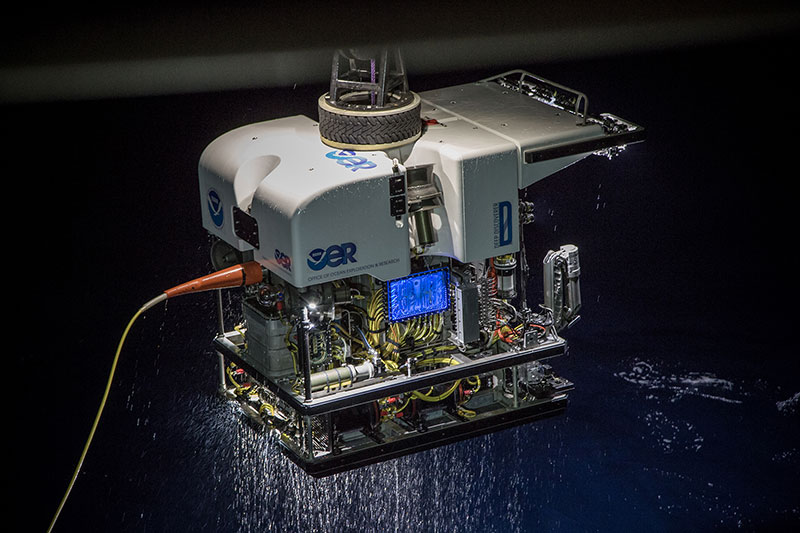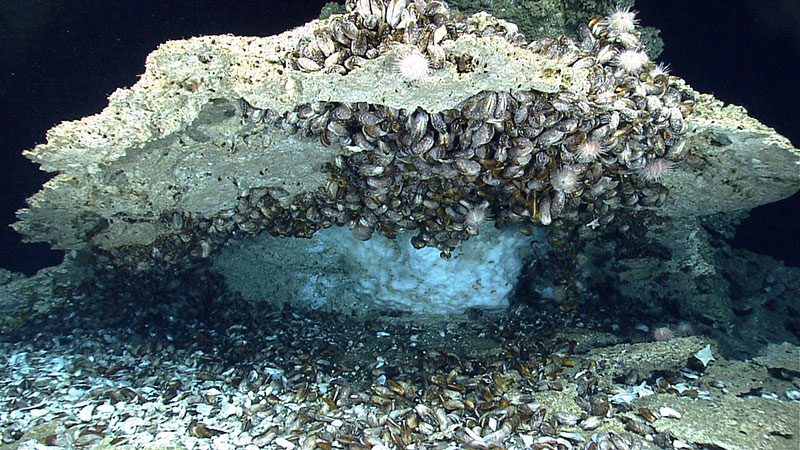
by Cheryl Morrison, Co-science Lead, U.S. Geological Survey

Methane bubbles flow in small streams out of the sediment on an area of seafloor offshore Virginia north of Washington Canyon. Quill worms, anemones, and patches of microbial mat can be seen in and along the periphery of the seepage area. Image courtesy of NOAA Office of Ocean Exploration and Research, 2013 ROV Shakedown and Field Trials in the U.S. Atlantic Canyons. Download larger version (jpg, 1.6 MB).
During the Windows to the Deep 2019: Exploration of the Deep-sea Habitats of the Southeastern United States expedition, the mission team will try to explore at least one cold seep site near the North Carolina coast. Cold seeps occur where highly saline and hydrocarbon-rich fluids, such as methane and sulfides, escape from the seafloor at close to ambient temperatures.
Cold seeps are an important component of deep-sea ecosystems because they often fuel entire communities that rely upon bacteria that convert chemicals (e.g., hydrocarbons) to food through a process called chemosynthesis. Some of these chemosynthetic bacteria are free-living and form mats that are visible on the seafloor, while others live within animals, such as tube worms or mussels, in a symbiotic relationship where the animal provides a home safe from predators while the bacteria create food for the host animal.
These symbiotic relationships often allow mussels and/or tubeworms to dominate cold seep habitats, where they create complex habitats utilized by other organisms, such as squat lobsters, crabs, shrimps, sea cucumbers, polychaete worms, and snails. Compared to many habitats in the deep sea, cold seeps are rich in food, attracting organisms from nearby to stop in for a meal. The combination of consistent, rich food sources and habitat complexity makes cold seeps oases in the deep sea.
The discovery of chemosynthetically driven communities is relatively recent. In 1983, Charles Paull made the first cold seep discovery at the Florida Escarpment in the Gulf of Mexico at 3,200 meters (over 10,498 feet). In the past 35 years, imaging of the water column as well as technical advances that allow exploration and characterization of extreme environments have made the discovery of many cold seeps possible.

Images of bubble plumes from gaseous seeps collected using water column acoustic reflectivity observations from NOAA Ship Okeanos Explorer Northeast and Mid-Atlantic Canyons Expedition. Also shown is associated bathymetry and seafloor backscatter. Image courtesy of NOAA Office of Ocean Exploration and Research. Download larger version (jpg, 2.7 MB).
Until the past six years, the only visually verified cold seep off the southeastern U.S. Atlantic Coast occurred at the Blake Ridge Diapir, first discovered in 1995. Increased mapping activities by NOAA Ship Okeanos Explorer identified bubble plumes emanating from the seafloor that are indicative of hydrocarbon gas leakage. Detection of bubble plumes suggests there could be upwards of 550 seeps along the U.S. Atlantic seaboard, yet all detected plumes may not represent high gas flux or well-developed chemosynthetic communities.

The red circles represent methane seep from the database of Skarke et al. (2014) based on NOAA Office of Ocean Exploration and Research surveys, with updates (many additions and a few deletions) based on geophysical surveys by the U.S. Geological Survey (USGS) Gas Hydrates Project in 2016 and 2017. Labelled seeps have been surveyed during ROV or deep submergence vehicle (DSV) Alvin dives since 2001, with most dives carried out since 2012 (compilation by C. Ruppel, pers. comm.). The yellow circles indicate the locations of seeps targeted for Deep Discoverer dives on NOAA Ship Okeanos Explorer Windows to the Deep 2018 expedition (EX1806). Detailed bathymetry on the upper continental slope from Andrews et al. (2016). Image courtesy of Carolyn Ruppel, USGS. Download larger version (jpg, 1.7 MB).
Visual evidence of chemosynthetic communities at areas of hydrocarbon seepage can be obtained either through remotely operated vehicles (ROVs), human-occupied vehicles (HOVs such as Alvin), or autonomous underwater vehicles (AUVs). This exploration enables the characterization of the species present, the spatial extent of the community, and possible zonation moving away from the active seepage. Several expeditions, including NOAA Ship Okeanos Explorer and other research cruises, have completed ROV dives confirming seeps close to canyons off the Northeastern U.S. (ex. July 12, 2013), and the mid-Atlantic (ex. Okeanos Explorer expedition: August 26, 2012, and May 8, 2013; U.S. Geological Survey expedition).
Generally, hydrocarbon seepage is patchy, and so it follows that chemosynthetic communities are also patchily distributed and often quite isolated from the nearest neighboring seep. Therefore, the sites this expedition plans to visit may be made up of species that occur nearby, or they could be different, with the potential for new life forms to be observed and documented.

Remotely operated vehicle Deep Discoverer during the Northeast and Mid-Atlantic Canyons Expedition. Image courtesy of NOAA Office of Ocean Exploration and Research. Download larger version (jpg, 1.8 MB).
At known seeps off the coast of North Carolina, bathymodiolin mussels are the dominant seep animals, so we may expect to find them during our seep dive as well. These mussels are known for extensive dispersal of their larvae, sometimes located in the upper water column where they may catch a long ride in fast moving currents, enhancing their dispersal ability.
Which species of bathymodiolin mussel may be present likely depends upon the depth of the seep site, as a turnover of species has been observed at depths greater than 1,000 meters (about 3,281 feet). For example, Bathymodiolus childressi is dominant at seeps occurring at less than 1,000 meters (3,281 feet) in the Gulf of Mexico, while Bathymodiolus heckerae, a species known from depths of 2,200 – 3,300 meters (7,217 - 10,827 feet) occurs at deeper Gulf of Mexico seeps as well as at the Blake Ridge Diapir site (2,500 meters; 8,202 feet) in the Atlantic Ocean. Given that mussel species are often difficult to identify visually, DNA sequences are often generated from tissue samples to aid in species identification and for comparison with mussels from other known seeps.

Bathymodiolus mussels (both dead and alive) found at cold seeps are seen underneath a carbonate overhang. Also visible under this overhang is methane hydrate. Image courtesy of NOAA Office of Ocean Exploration and Research. Download larger version (jpg, 1.7 MB).
Although we’ve made great progress documenting new Atlantic Ocean seep sites in recent years, there are still many out there to be found. Documenting where chemosynthetic communities exist and what species are present is important to effectively manage offshore resources and adds missing pieces to the complex puzzle of how these chemosynthetic islands of life may be connected globally.